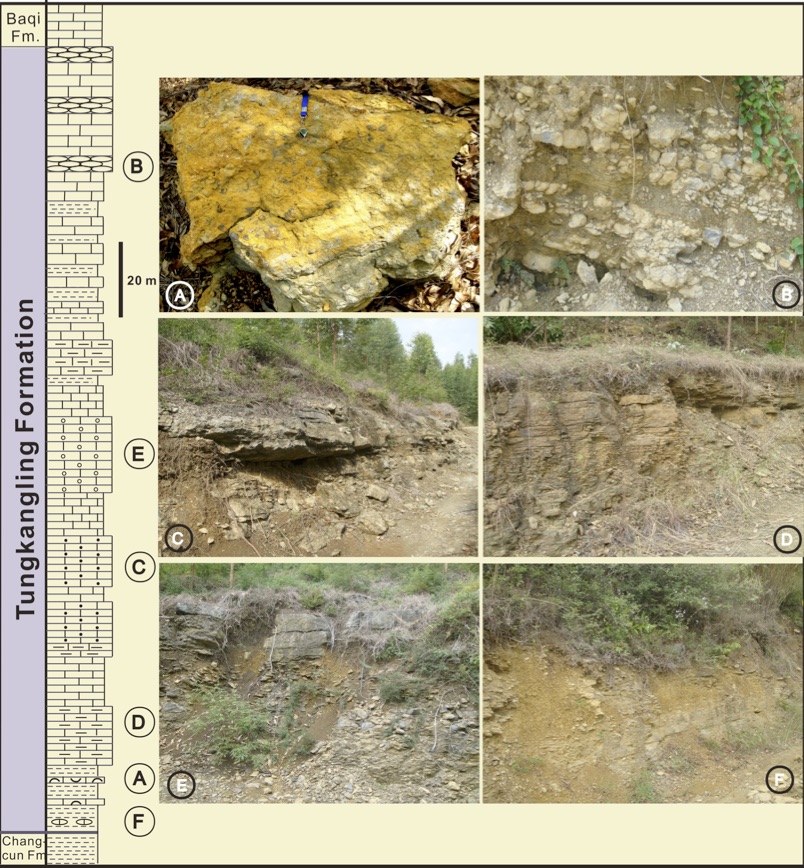Donggangling Fm
Type Locality and Naming
The type section is located at Doupengling, 1.5 km east of Xiangzhou County, Guangxi. It was named by Yue Senxun in 1928. Due to there are some faults in the type section, which led to the stratigraphic missing of the lower parts, a lectostratotype is defined from the Ma’anshan Hill, about 26 km northeast Xiangzhou.
Synonym: Tungkangling Fm
[Figure - Map showing the location of lectostratotype of Donggangling Formation]
Lithology and Thickness
Limestone. Formation is composed of limestones, clayey limestones, mudstone and shales. Grainstone, nodular limestone and oolitic limestone are present. Gray, dark gray medium-bedded wackestone to packstone are the dominant texture within the formation consisting of either clay-size or both silt-size detrital grains. The biocalsts include bivalves, gastropods, brachiopods, stromatoporoids and crinoids. Other non-fossiliferous framework grains include peloids, intraclasts and rare algae ooids. Sedimentary structures include wavy to horizontal laminations, rare desiccation cracks and fenestral structure are also observed. Nodular limestone is fine-grained bioclastic wackestone intercalated with shale or marls and contains relatively abundant conodonts. The gray, grayish green calcareous mudstones are laminated and commonly weather to soft powder. The clayey limestone yielded most of megafossils, such as brachiopods, corals, stromatoporoids, and bryozoans, which is mainly developed at the lower part of this Formation, The thickness of this Formation is 200 m or so.
[Figure - Columnar section of the Donggangling (Tungkangling) Formation at the Ma'anshan Hill with main outcrops showing the lithological features. A-shelly limestone, B-nodular limestone, C-bioclastic limestone, D-detrital limestone; E-argillaceous limestone; F-marls.]
Relationships and Distribution
Lower contact
Conformably lies on the clastics of the underlying Changcun Fm,
Upper contact
The Formation is conformably overlain by the Baqi Fm.
Regional extent
It is widely distributed in west of Dayaoshan
Mt. covering Lipu, Tongmu, Xiangzhou, Wuxuan, Wuming and Guiping of central Guangxi and Hezhou-Yangsuo of northeast Guangxi as well as in southwestern Guangxi and southeastern Yunnan..
GeoJSON
Fossils
Brachiopods: The brachiopods are very common, especially in the lower part of Tungkangling Formation. Stringocephalidae suddenly occurs and is particularly well developed, including Stringocephalus (obesus Grabau), Acrothyris (kwangsiensis Hou), Leioseptathyris (modica Wu), Parabornhardtina (yunnanensis Sun and Hou) Pseudobornhardtina (xiangzhouensis Yang), Rensselandioidea (maanshanensis Yang) and Xiangzhounia (typical Ni), 1974). Those species, such as Emanuella takuanensis, Guangxiispirifer subaequata, Rhynchospirifer magnus, Ilmeniopsis changtangensis, Zhongpingia cimicinoidesformis. Gypidula calceola, Indospirifer maoerchuanensis, I. changulienesis, Spinatrypa bodini, Undispirifer undiferus, Hypothyridina sp. are commonly seen (Grabau, 1931; Wang et al., 1974; Yang, 1983; Xian, 1983). A bed of shelly limestone with small sized Emanuella occurs at the uppermost part of conodont Lower varcus Zone.
Rugose corals:The rugose corals are very abundant in the limestones, argillaceous limestones and mudstone of the Donggangling Formation. The solitary corals are mainly Cystiphylloides, Grypophyllum, Neosyringaxon, Sinospongophyllum, Sunophyllum, Stringophyllum, Temnophyllum and compound corals are commonly Dendrostella, Disphyllum, Paramixogonaria, Phacellophyllum, Endophyllum, Frechastraea, Phillipsastraea, Argutastraea, Columnaria and Hexagonaria. The first four genera are dendroid or phaceloid and the rest are massive including cerioid, asteroid, aphroid and thamnasterioid morphology. Some of them (such as Temnophyllum, Phacellophyllum, Argutastraea, Hexagonaria, Disphyllum, Frechastraea, Phillipsastraea, etc.) can extend to Upper Devonian Frasnian and others (for example Sinospongophyllum, Sunophyllum, Stringophyllum, Neosyringaxon, Endophyllum, etc.) only limited in Givetian.
Others: Stromatoporoids, tabulate corals and bryozoans are common in the Donggangling Formation but no special study was given for them. On the basis of stratigraphic records in some geological reports the following fossil names are quoted here for reference.
Stromatoporoids: Stromatopora maillieuxi, S. sublamellata, S. reticulate, S. ertangensis, S. dubia, S. porosa, Clathrocoilona restricta,C. abeona,Trupetostroma ruedemanni, T. exguisitum, Salairella multicea, Pseudoactinodictyon lenticulare, P. juxi, Hermatostroma porosum, H. schliteri, Stromatoporella disjuncta, Atelodictyon sp., Hermatostroma schluteri, Stachyodes radiate, Idiostroma cf. reticulatum, Parallelopora simplex, P. ertangensis.
Bryozoans: Fistulipora oblongata, F. karzevae, F. frondosa, Stereotoechus? problemus, Helopora devonica, Eridotrypella ornate, Rhombopora sp.
Tabulate corals: Roemeripora raritabulata, Caliapora sp., Trachypora sp., Crassialveolites sp., Gracilopora sp., Coenites fascicularis, Placocoenites sp., Aulostegites sp., Caliapora sp., Thamnopora ex gr. nicholsoni, Alveolites sp.
Age
Depositional setting
It is interpreted as an open to restricted platform environment.
Additional Information

